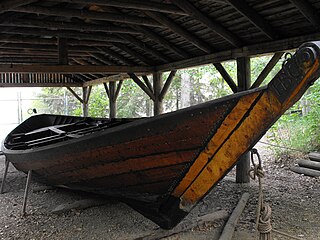Leaving Fort Garry
In his book En route pour la mer Glaciale [6] Father Emile Petitot recounts his 1862 trip with the Portage La Loche Brigade. He left Fort Garry on 8 June as a passenger with the Lesperance brigade. The other brigade guided by Jean Baptiste Bruce had left a week earlier. He arrived at the Portage 42 days later on 20 July. In the following translation Petitot describes leaving Fort Garry. [7]
"The distance from Fort Garry to Portage La Loche was 482 French leagues (1446 miles) which we would undertake in a small vessel called a York boat. York boats are flat bottomed, pointed at both ends and displace 8 to 9 tonnes, which give them a capacity of 4 to 5,000 kilos. The keel measures normally 30 to 36 feet. It is rowed or sailed and steered with a long ‘aviron’ called a sweep and a rudder. The York boat is crewed by nine to ten men, a helmsman called a 'gouvernail', a bossman or ‘devant de barge’, and eight rowers called the ‘milieux’. These milieux were also the porters. Our guide was an old French Canadian called Alexis Lesperance. At 80 years old his actions were slowed but not his voice. His boat, always the first, was guided by his son. A kind of guide, the Metis Michel Dumas, led our boat. Our cook and porter was another Metis called Baptiste Boucher, ‘mangeur de lard’ (greenhorn) like us who was forced to come out of need. Our brigade had seven boats, all crewed by French Metis with a few Swampy Cree and Chippewa Christians.
A great cry: “Aoh! Aoh!” Pousse au large!” came from the lungs of Lesperance, made me understand that the old guide, however white haired he may be, was nevertheless still green and full of energy. A savage cry: “Wi ! Wi !” uttered by the crews, answered this order, and the seven York boats took their leave on the ‘Miskwa-Kamaw Sipiy’. Twenty five years later I still seem to see the pitiful figures that Grouard and I made in our boat filled with sugar boxes, barrels of powder, bolts of cloth and cases of tobacco, with only a felt hat for shade, seated on the first piece of baggage we found."
At the Stone Fort, Petitot bought more provisions for his journey. His complete list of supplies included 125 kilos of flour, two bags of sea biscuits, 25 kilos of pemmican, 4 smoked and cooked hams, 6 large loaves of bread, a big bag of buffalo tongues and smoked meat, a small case of eggs, a little bag of onions, 3 pounds of Congo tea, a small barrel of maple syrup; some sugar, ground coffee, salt, pepper and butter. Two blankets rolled in an oil skin bag, a hatchet and a case of clothes completed his baggage.
Father Émile Grouard who was travelling with Petitot also described the experience in his book "Souvenirs de mes soixante ans d'apostolat dans l'Athabaska-Mackenzie"
"Monsignor Taché had made arrangements for our passage, Father Petitot and I, with the Hudson's Bay Company on the boats leaving that afternoon of Pentecost for Portage La Loche."
"We each had our travel case, and Monsignor Taché had supplied for our voyage: thick wool blankets wrapped in oilskin, a tent, a stove, a tea kettle, plates and iron pans, knives and forks, a bag of dried meat, a large sack of pemmican, a barrel of biscuits, some ham, tea, sugar. We were to live on this for two months. Monsignor had also arranged for a Métis to do our cooking and to help us set up our tent every night and take it down every morning. He suggested that we be quick to obey the guide's signal: "Lève ! Lève!" in the morning and not to delay getting into the boat. He led us to the river's edge, gave us his benediction, embraced us tenderly like a father would and we took our place on the boat." (translation) [8]
The following are Joseph James Hargrave's estimates of the dates when the brigades arrived and left each section of the route. The dates are from his 1871 book, Red River, [9] a history of the Red River Colony.




















